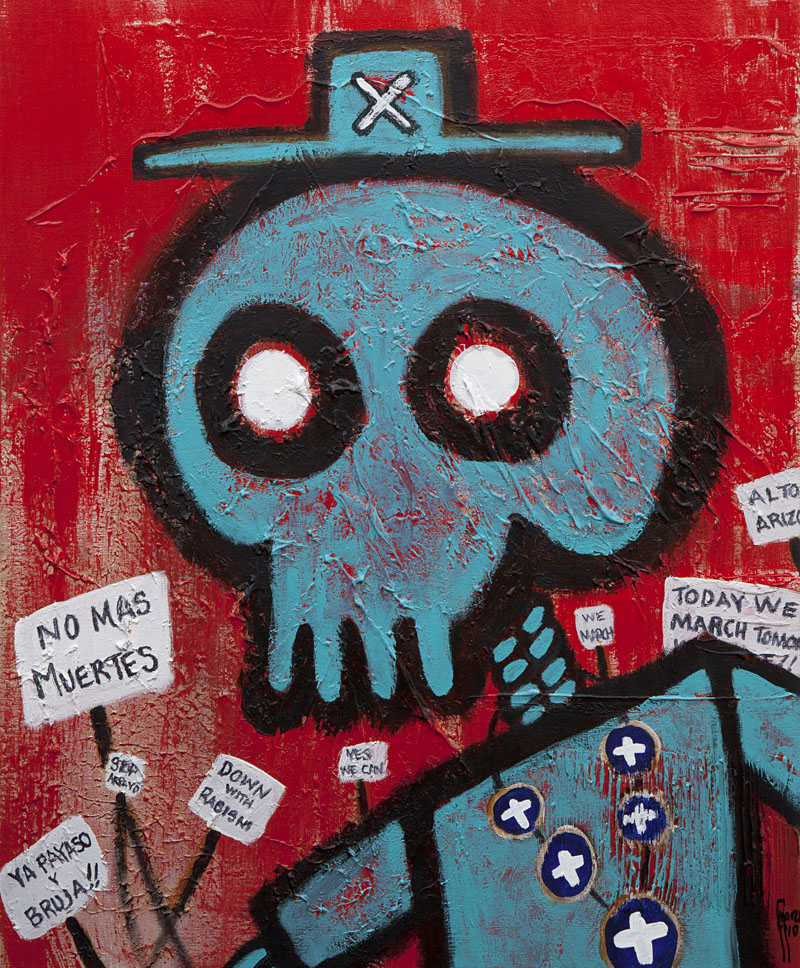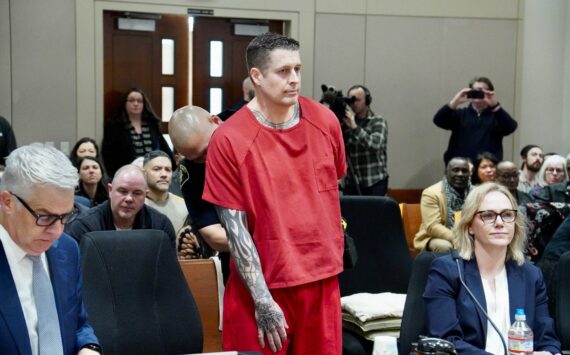Consorting with anti-immigrant enforcers, indulging rank opportunism, and adhering to failed policies seem an unlikely recipe for change we can believe in. And yet this very cocktail of mediocrity — stirred by an early endorsement of Barack Obama — has thrust Arizona Governor Janet Napolitano into the heady midst of Washington’s inaugural speculation.
She finds herself on the president-elect’s short list for a cabinet seat, as well as on Saturday Night Live‘s hot seat for parody.
The governor captured the front page of American journalism this month with the announcement that she is the frontrunner to take over the Department of Homeland Security. Napolitano must protect this nation’s borders and ensure our safety from terrorism and natural disasters while overseeing billions of dollars in contracts in service of theses goals.
Janet Napolitano has considerable experience failing at administrative oversight.
But it is her role in securing Arizona’s frontiers that bears scrutiny.
Confronted with a border state’s unavoidable immigration challenges, Napolitano defended the citizenry with a devil’s pitchfork. Her multi-pronged strategy: embrace the nation’s most regressive legislation; empower a notorious sheriff using cynical political calculations; employ boots on the ground.
And yet she remains beloved by Democratic apologists. Those who cling to Napolitano point out that the alternative to her tepid, and occasionally disgraceful, leadership would be a Republican. That sends her partisan supporters to the fainting couch.
Her faithful base, supine with the vapors, is in no position to consider the record.
Here, quite simply, is the situation.
According to September’s GAO report, Homeland Security squandered $15 billion in the past five years on contracts that failed, fell behind schedule, or were over budget. From Katrina to airport security, federal money grew on stunted trees.
And there is little reason to believe this is the sort of mess Napolitano can untangle.
In Arizona, the Department of Transportation, which Napolitano oversaw, bungled billions, the largest contracts in the state’s history, by hiring firms embedded with the state agency’s former employees and cronies. The ballot proposition that made all this possible was financed, of course, by the very corporations that stood to benefit. The glaring favoritism in the roadway contracts precipitated expensive litigation (“Friends at Work,” Sarah Fenske, June 1, 2006).
Furthermore, Homeland Security, like every government agency, is under acute budgetary pressures having little to do with malfeasance.
Facing similar revenue shortfalls in Arizona, Napolitano ducked hard choices, refused to tighten the state’s belt and opted for accounting gimmicks: highway radar to raise funds with increased ticketing of motorists; future lottery money diverted to current funding gaps.
Mere corruption, greed, and the cupidity of boondoggle bookkeeping in hard times — these are simple things to understand, if not sanction, within a state government.
But when the Valley of the Sun was in crisis, when the community was torn apart by the worst human-rights tragedy in the state’s history, the central villain owed his political power to Janet Napolitano.
And when Arizona became the epicenter of anti-immigrant fever, when armed militiamen patrolled our southern flank with Mexico, our governor followed the advice of a notorious outlier congressman, an anti-immigration foghorn of despair.
She militarized the border.
The mere suggestion of work visas or a reasonable path to citizenship for the 12 million Mexicans living in America burned both President George W. Bush and John McCain in the wildfires of anti-immigrant populism before the election.
Immigration was the only major issue facing this nation that was studiously avoided by the candidates in the presidential campaign. The future of this hot-button issue is, at best, murky.
In Arizona, Governor Napolitano fed — and fed upon — the anti-immigrant fever that rages in our state. Though Napolitano’s reputation is that of a modest progressive, her true profile is that of a pragmatist who is willing — in fact, is adept — at riding political currents.
She has signed several pieces of legislation that have criminalized that most human desire: the need to work and feed one’s family.
This remarkable definition of lawbreaking behavior has created an era in Arizona that is the equivalent of a new Prohibition. Once, teetotalers, the temperance movement, and the anti-saloon league drove us into the Noble Experiment and the hands of mobsters. Today, those who migrate here seeking work, like those who once sought drink, are increasingly in the grip of organized crime.
“As the border gets tighter and tighter, it requires more professional smuggling operations,” said Jennifer Allen of the Border Action Network. “It makes everyone more desperate to ensure that the cargo gets across.”
Governor Napolitano took a page from the anti-immigrant playbook and deployed the National Guard to the state’s border with Mexico.
“Cartels fight for corridors, violence increases as they move contraband across the border. We’ve seen increased violence with the militarization,” observed Allen.
And that violence has moved north away from the borders and into our cities.
There is little argument that Governor Napolitano was an accomplice.
She signed a piece of legislative mischief in 2005 known as the anti-smuggling statute. Designed to further criminalize organized smuggling, the law was redundant, and she was counseled not to lend her support.
“We urged her not to sign that bill,” said former Senate majority leader and immigrant rights advocate Alfredo Gutierrez.
In short order, Maricopa County Attorney Andrew Thomas issued a formal opinion stating that all illegal aliens, not just the smugglers, would be prosecuted under the statute.
Arizona law now equates the impoverished human cargo with the smugglers who transport the gardener, the dry-waller, the maid, and the babysitter.
“We are the only state in the union where coming across the border is a felony,” said Gutierrez.
Napolitano also signed the nation’s toughest employer-sanctions legislation.
The heads of the cartels and the crop-pickers, the bossed and the boss — everyone is equally guilty.
In the same year that she signed the smuggling bill, Governor Napolitano declared a state of emergency using the fallout from unauthorized immigrants to garner seven-figure disaster relief from the federal government.
Responding to Napolitano’s 2005 state of emergency declaration, Congressman J.D. Hayworth attacked Napolitano for leeching off the federal teat and suggested that what the governor ought to do is call out the National Guard instead.
An anti-immigration barnburner, Representative Hayworth’s crack-skull theatrics made him notorious. Washingtonian magazine identified Hayworth in 1998 as the second-biggest “windbag” on the Hill after surveying 1,200 congressional staffers. He once suggested that Arizona ranchers had discovered the hastily abandoned prayer rugs and Korans of Muslims sneaking across the Mexican border into the United States. Hayworth’s dissemination of this sort of Internet gossip — mixed with his propensity for using disgraced lobbyist Jack Abramoff, who provided the Arizona congressman with sports-arena skyboxes for fund-raising — eventually led to his ouster by voters.
And yet Napolitano took to heart Hayworth’s idea of the militarization of the border.
Aware that the congressman was considering a run against her, Napolitano deployed the Guard to Arizona’s border with Mexico.
“She won accolades from every anti-immigrant group in the country,” said Alfredo Gutierrez. “Using troops was stunning, shocking.”
Gutierrez drew a distinction between her deployment of soldiers and the patrols of citizen militias who were also active on the border. The Guard was not used to hunt down Mexicans.
“She read the political tea leaves, so she deployed troops, but she also limited the troops to a supporting role digging ditches,” said Gutierrez.
While the Border Patrol attempted to beef up staffing, the Arizona National Guard busied itself with support work that allowed the expansion of the controversial border fence that now occupies approximately 200 miles.
Still, Napolitano opposes fencing off our border, having rather famously noted that when you build a 50-foot fence, smugglers build a 51-foot ladder.
Not only did she send the Guard in to support work she did not believe in, she dispatched the troops shorthanded.
Last year, the Associated Press reported that the Arizona National Guard lacked more than $400 million in equipment, including some 100 trucks, tractor-trailers, forklifts, flatbed trailers, mobile tool shops, M-16 rifles, fuel tankers, and radios. It deployed with 39 percent of its “mission essential” materials.
Governor Napolitano hardly skipped a beat.
“We are still sound to deal with the kinds of natural catastrophes we’re likely to experience in Arizona absent something truly unusual,” said the governor in response to news reports. It was not a reassuring assessment and brought to mind the sort of double-speak made famous after Hurricane Katrina, not to mention the equipment issues that surfaced after the attacks on the World Trade Center when first-responders found their communications equipment deficient.
Between the virulent pedagogy of Hayworth and his anti-immigrant ilk and the superficial shape-shifting of Napolitano, Mexicans crossing our border remain Arizona’s most volatile issue.
Since 2004, Arizona has counted a yearly average of more than 200 Mexican bodies in our deserts — people who perished on their way north. As of September 2008, we were on track with 152 corpses.
In response to a militarized border — as well as checkpoints, fences, obstacles — the drug cartels have moved into smuggling in a big way.
They have brought violence and extortion to our cities.
Phoenix police recently reported that the Prohibition-like criminalized smuggling has also spawned 266 kidnappings for ransom and 300 home invasions within the city’s immigrant community.
Police estimate that, because of fear of deportation, the actual numbers for kidnappings and home invasions could be three times higher.
Janet Napolitano strode onto the national stage in 1991, as a key player in the Clarence Thomas Supreme Court hearings before the Senate Judiciary Committee. She prepared witness testimony on behalf of Anita Hill.
The hearings foreshadowed Napolitano’s political strength of obscuring failure while rallying a constituency.
“It really did bring home how issues of women really didn’t have an avenue to be heard at that time,” Napolitano said of the experience.
This posturing conveniently overlooked the fact that the Thomas hearing provided an unprecedented “avenue”: the United States Senate. Far from being ignored or shunted aside, the proceedings were broadcast throughout the land. The Hill allegations were, in fact, heard; Napolitano simply failed to block the ascension of Thomas.
Shortly thereafter, President Bill Clinton nominated Napolitano to be the United States Attorney for the state of Arizona, despite the fact that she had never prosecuted a single case.
Her appointment was delayed for more than a year as the Senate wrangled over whether or not she had coached a critical Hill witness to change testimony.
As an inexperienced United States Attorney, Napolitano’s political calculations would protect Arizona’s most notorious violator of human rights, a sheriff who would go on to campaign in the presidential primaries as an anti-immigration spokesman.
Governor Napolitano teamed up with Sheriff Joe Arpaio in a jointly signed letter of complaint to the head of Homeland Security, Michael Chertoff, on August 14, 2006.
The Napolitano and Arpaio correspondence is, frankly, bizarre.
Their complaints regard the head of the Immigration and Customs Enforcement Agency (ICE) in Arizona, Robert Medina. The governor and the sheriff wanted more cooperation.
But Medina’s departure from Arizona to Texas had already been announced. He was replaced by Alonzo Pena (who has now been replaced by Matthew Allen).
The note, and the accompanying press release, appeared to be a political stunt to shore up the governor’s tough-on-immigration credentials before the fall election. And her coordinated effort with Arpaio would bear rotten fruit.
At the time of the letter, Arpaio had twice been refused efforts to have his deputies cross-trained under 287(g) to arrest illegal aliens.
Once Arpaio’s staff and his posse were trained by ICE, the sheriff and his deputies stepped up anti-immigrant enforcement and all hell broke loose.
Arpaio’s raids became infamous nationally. His highly publicized sweeps into Mexican neighborhoods saw people with brown skin pulled over unilaterally.
Phoenix Mayor Phil Gordon, in a singular act of courage, demanded this past April that the FBI investigate the sheriff’s alleged racial profiling, accusing Arpaio of “a pattern and practice of conduct that includes discriminatory harassment, improper stops, searches, and arrests.”
A Justice Department probe is ongoing.
The thug tactics of the sheriff made him a darling of conservative cable television and national talk radio and a target of the New York Times, the Wall Street Journal, and other mainstream media.
But the closed-border crowd loved Arpaio. Mitt Romney even summoned the sheriff to the Midwest to drum up anti-immigrant voters during the Republican primaries.
Sheriff Arpaio’s roundups climaxed shortly before this month’s election when a heavily armed posse raided the City Hall and library of Mesa, a community where the chief of police and mayor had publicly opposed Arpaio’s brutal tactics. Armed like SWAT teams and accompanied by dogs, more than 60 deputies arrested three suspected Mexicans employed to empty trashcans.
The sheriff that Napolitano had teamed up with, when it suited her political agendas, was so out of control that the governor eventually cut off what funds of his she controlled through federal grants. It slowed Arpaio down not one bit.
But Governor Napolitano, better than almost anyone, knew precisely what she was doing when she, once again, cynically climbed into bed with the sheriff to write Michael Chertoff.
If not for Governor Napolitano, Sheriff Arpaio would, and should, have been prosecuted 10 years earlier.
The Justice Department of the United States notified the Maricopa County Board of Supervisors on March 25, 1996, that Sheriff Joe Arpaio was under investigation. In a 15-page letter, federal prosecutors laid out their concerns that Arpaio had willfully violated the constitutional rights of prisoners in his jail.
The concerns were not picayune. Arpaio was accused of excessive brutality and ignoring serious medical needs.
Janet Napolitano, U.S. Attorney for Arizona, was part of the Justice Department and kept in the loop. In fact, she was copied on every piece of correspondence in the matter.
Not coincidentally, Arpaio’s tactics endeared him to the voting public, which kept the sheriff’s approvals rating near an unprecedented 80 percent. The sheriff propelled this groundswell of support with an unending series of media pronouncements about his prisoners: “Making conditions so miserable they will never want to come back,” “It’s lucky [they] have food.”
The sheriff bragged that he spent more on feeding the department’s dogs than he spent on inmate chow. He clothed them in pink underwear, housed them in tents, and worked them in chain gangs. While the conditions garnered enormous gouts of publicity, the stunts masked the brutal conditions inside the cells.
In June, three months after the Justice Department’s letter, Arpaio’s jailers killed inmate Scott Norberg.
The following year, 1997, U.S. Attorney General Janet Reno lodged an official complaint in the courts against the sheriff over the conditions in the jail.
As is common in these cases, the Justice Department reached a settlement with the sheriff in which he agreed to a long list of stipulations designed to alleviate the human misery in his cells.
But Arpaio’s capitulation to the Justice Department was hailed by the sheriff, not surprisingly, as a victory over Washington bureaucrats.
If Arpaio’s smug declarations were not a shock, the behavior of Napolitano was.
About to declare her own candidacy for Arizona Attorney General, Napolitano joined Arpaio at his press conference in a blatant attempt to court the sheriff’s support in her upcoming race.
Napolitano declared the federal lawsuit nothing more than a “technicality” and castigated the settlement as merely “a lawyer’s paper” (“U.S. Lawsuit Re-Alleges Abuse in Jails,” Tony Ortega, November 6, 1997).
Sheriff Arpaio was thrilled and threw his considerable support behind Napolitano in the election.
The details behind the Justice Department investigation and the reforms that Arpaio agreed to enact should pose little mystery to Barack Obama.
The 1996 letter citing Arpaio’s violation of prisoners’ constitutional rights was signed by Obama’s close personal friend and the current governor of Massachusetts, Deval L. Patrick, then-assistant U.S. attorney general in the Civil Rights Division.
What Obama cannot know is that Janet Napolitano’s protection of Sheriff Joe Arpaio was more nefarious than has been reported.
In a recent interview, the attorney for the deceased Scott Norberg revealed for the first time that Napolitano’s behavior went shamelessly beyond simply endorsing Sheriff Arpaio.
In Arizona, the killing of Scott Norberg on June 1, 1996, dogs Arpaio in the press to this day. The story appears whenever an overview of the sheriff is written.
What has never been revealed is the role Janet Napolitano played in protecting the sheriff from indictment.
When an unconscious Norberg did not respond to a deputy’s command, the victim was attacked and beaten by nearly a dozen jailers. The initial violence was witnessed by a holding tank full of prisoners. Norberg was then transferred to a restraint chair where he was shackled and further pummeled until he died.
The family’s subsequent lawsuit was settled for more than $8 million dollars in 1999, three years after the death and three years after the letter from the Justice Department.
This month, the Norberg family’s attorney, Michael Manning, revealed that Sheriff Arpaio was involved in a massive cover-up that provoked the lawyer to turn over evidence to the FBI.
Notes taken by a deputy the night of the killing were destroyed. Critical X-rays were destroyed. County authorities, under the watchful eye of the sheriff, hid the fact that Norberg’s larynx was fractured.
When the family’s independent autopsy uncovered the larynx fracture, county authorities claimed the damage to the bloody tissue must have occurred following the death, a biological impossibility. After the county demanded to take custody of the larynx, the evidence was then destroyed.
Manning handed over numerous boxes of evidence to the FBI and then submitted to two interviews with Napolitano’s staff. He characterized the prosecutors as very excited by the evidence and the interviews.
Keep in mind that, by the time Manning revealed the details of the cover-up and the destruction of evidence, Napolitano had already appeared at a press conference absolving Arpaio of any responsibility in the Justice Department settlements.
Keep in mind, too, that Napolitano was fully aware of the Justice Department settlement details, including Eugene Miller’s report that noted in brief: “It is quite evident in watching these [jailhouse] tapes that in each of these incidences that the use of force was unprovoked, unnecessary and, consequently, unjustified and excessive . . . A code of silence appeared to be operating as nurses and other staff were observing the abuse and looked the other way.”
Napolitano did not receive the Norberg files from Manning in a vacuum.
“The evidence was compelling,” said Manning earlier this month. “The assistant U.S. attorneys took it to Janet, and she said, ‘No!'”
Napolitano did more than merely prop up Arpaio after he agreed to settle with the Justice Department.
Presented with the evidence of a criminal conspiracy and the destruction of evidence, Napolitano refused to prosecute Sheriff Joe Arpaio.
It is no wonder that he then endorsed her bid for election as Arizona Attorney General.
What is surprising is the role they will jointly play in immigration.
Unlike President-elect Obama, Governor Napolitano never pointed us toward horizons that beckoned with promise; instead, she lifted a damp finger ever in search of a breeze.
Nowhere is that caution more apparent than in another border crisis, this one domestic.
If there is a single Arizona issue that suffered from a lack of leadership, that demanded politics take a back seat to character, it was the state’s polygamy scandal. Is there a rising national star in this drama?
Napolitano’s failure to deal with this crisis should make the Obama administration doubt whether she has the courage to attack problems that will surely plague her as Homeland Security chief.
In 2002, New Times reporter John Dougherty began a remarkable investigation into the nation’s largest polygamous sect. Over a span of five years and 33 articles, Dougherty shed a harsh light upon the practices of the 8,000 members of the Fundamentalist Church of Jesus Christ of Latter-day Saints (see “Polygamy in Arizona,” at phoenixnewtimes.com).
Child abuse, sex crimes, welfare fraud, tax evasion, diversion of state school funds to church purposes and stunning genetic health problems infested Colorado City and Hildale, two polygamist communities that straddled the Arizona-Utah border. The case was complicated by the church’s vast holdings on both sides of the border. At one point, lawyers defended men against charges of sex with underage girls by claiming that prosecutors did not know in which state the sex acts had occurred.
Underage girls, the estimates climbed into the hundreds, had been forced into “marriages” with men who already had wives.
Despite enormous holdings, as well as a trust valued well north of $100 million, Arizona taxpayers underwrote the polygamists to the tune of $20 million annually, including $172,000 in monthly food stamps. Church leaders stole so much money from the state that they referred to it as “bleeding the beast.”
Since 1990, the state had been treating a rare and devastating genetic disorder within the polygamous sect. Although some 8,000 strong, approximately half the community was primarily descended from only two families who had intermarried with abandon. Fumarese Deficiency was occurring within this isolated sect with the greatest concentration in the world. At the time of the series, about 20 children were afflicted.
“Victims suffer a range of symptoms, including severe epileptic seizures, inability to walk or even sit upright, severe speech impediments, failure to grow at a normal rate, and tragic physical deformities,” noted Dougherty in one article.
The community was receiving $12 million annually to pay for health insurance premiums.
Before Dougherty was done, the FLDS would come under intense government scrutiny. Their leader, Warren Jeffs, was placed upon the FBI’s 10 Most Wanted list.
Yet both as Arizona Attorney General and governor, Janet Napolitano was more than ineffective in the face of this crisis. She was silent.
Although the FLDS is a breakaway cult from the Church of Jesus Christ of Latter-day Saints, many current members of mainstream Mormonism have decidedly mixed feelings regarding their history of polygamy. Furthermore, politically active Mormons continue to exercise huge political sway in Arizona. During Dougherty’s series, church members held the key legislative chairs in the statehouse, including Senate President Ken Bennett and Speaker of the House Jake Flake. Flake was, in fact, the descendent of a prominent polygamist patriarch.
The last time a governor had tried to go after the polygamists, it was a political disaster. In 1953, Governor Howard Pyle was voted out of office after he raided the polygamous community of Short Creek.
Napolitano’s dithering suggested she was too concerned about political fallout to act decisively.
The Governor’s Office, frustrated at the repeated questioning of her seeming inability to act, lashed out at Dougherty.
“We can’t fix every problem at once,” the governor’s spokeswoman, Jeanine L’Ecuyer, famously responded to one of the reporter’s questions. “The question [of what to do] is a big one. It’s a broad one, and it’s a difficult one to answer.”
Napolitano never did, in fact, solve the issue. She never addressed any part of the problem.
In 2002, a spokesman for then-Attorney General Napolitano told Dougherty her office had an investigator on the polygamy situation five separate times. Napolitano’s grand jury proved inconclusive.
As law enforcement scrutiny lingered over years, residents of the two border towns began to build fortifications. Prophet Warren Jeffs vowed never to be taken alive.
“Does he have bodyguards? Yes. Are they armed? Yes. Will they put down their lives for him? Yes.” One investigator told Dougherty.
“You know damn good and well nobody wants to go there,” said Mohave County Supervisor Buster Johnson in 2005. “Everyone is damn afraid of another Waco.”
In her entire tenure as attorney general and governor, Janet Napolitano assigned one part-time worker from Child Protective Services to face the polygamy issues.
In 2005, other authorities took matters into their hands.
Arizona Attorney General Terry Goddard and Utah Attorney General Mark Shurtleff, as well as Arizona’s Mohave County Attorney and Utah’s Washington County Attorney, moved to end the abuse. Arizona Superintendent of Schools Tom Horne joined in the legal assault.
In January 2006, federal agents raided the community and served 66 grand jury subpoenas.
“Today, we have sent a message to Warren Jeffs that those marriages will not be tolerated, and we have also sent a message to the young women in Colorado City that they are entitled to the protection of the law,” said one prosecutor after the conviction of church leader Ron Barton.
Warren Jeffs was arrested August 31, 2006, while on the run on a Nevada interstate. He was in possession of 16 cell phones, disguises, a dozen pairs of sunglasses, three wigs, and $55,000 in cash.
He was tried and convicted on two counts of rape in September 2007. He was sentenced to two five-year-to-life terms to be served concurrently.
As Arizona’s top executive, Governor Janet Napolitano carved her niche as a champion of children.
We ask those who trumpet her nomination to Barack Obama’s cabinet: But who is against children?
It is not a facetious question. In any case, Arizona’s metrics that measure educational achievement are as low as they are irrelevant to the job at hand. All-day kindergarten has less than nothing to do with Homeland Security.
As she is an advocate for the smallest amongst us, so too, we assume she is steadfast against terrorism.
Her abilities on that front are a mystery.
What we know, and what she is known for, is that along with President George Bush, she militarized our border with Mexico by deploying thousands of National Guard troops.
And this year, the Guard was replaced by a vastly expanded Border Patrol.
Hovering at about 16,000 officers, the Border Patrol is a force to be reckoned with upon our border.
“There are 6 million people who live on the American side of our border with Mexico,” the Border Action Network’s Jennifer Allen said in a recent conversation. “They live there, hunt there, hike there. We now have a climate of fear.”
Allen noted that in Douglas, Arizona, roughly 15,000 people reside and are under the watchful — and occasionally intrusive — eye of 500 Border Patrol agents.
“That’s one in 30,” said Allen. “I just got back from a meeting in Washington with the head of the Border Patrol, David Aguillar. He told me he regards his force as ‘paramilitary.'”
As much as critics wish it were so, it is not just the American government that has militarized the border.
More than 4,000 people have been murdered on the Mexican side of the border in the past year.
The Mexican government is using armed federal troops to hunt down drug dealers from the cartels, and the carnage is remarkable.
In January 2007, a small contingent of the National Guard pulled back from their posts when four armed men approached in military fashion from the Mexican side of the border. Bloodshed was avoided.
But the Border Patrol routinely is dealing with armed couriers smuggling drugs and people.
In his recent book on Lincoln, James M. McPherson quotes from Carl von Clausewitz’s 1873 treatise Vom Kriege: “It is clear that war should never be thought of as something autonomous but always as an instrument of policy.”
Having militarized our border, what is our policy?
Is Janet Napolitano capable of articulating a policy beyond her desire, often expressed, of wishing that the federal government had such a policy.
The Border Patrol claims that immigration is down because they are apprehending fewer Mexicans than in the past.
As the Economist pointed out, that is rather like estimating the number of fish in the sea by counting those in your net.
We know that money sent home to Mexico from the United States has exploded from well under $2 billion in 2000 to $6 billion today.
Arriving at a border policy is, after the economy, the greatest challenge facing the nation, and there is little indication that immigration is moving to any quick consideration (even Lincoln waited some years to address slavery).
President Bush and Senator John McCain were both silenced by populist outrage within their party when they proposed answers.
Directing Homeland Security, protecting our border with Mexico, and helping to articulate an immigration policy will require leadership and character.
Governor Janet Napolitano’s qualifications are less than modest.







